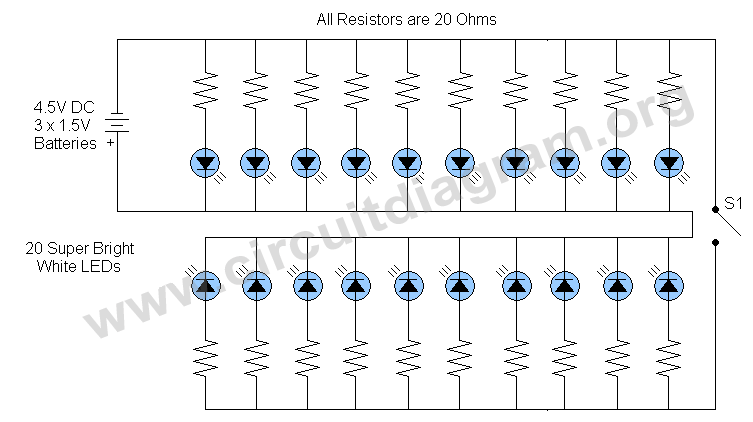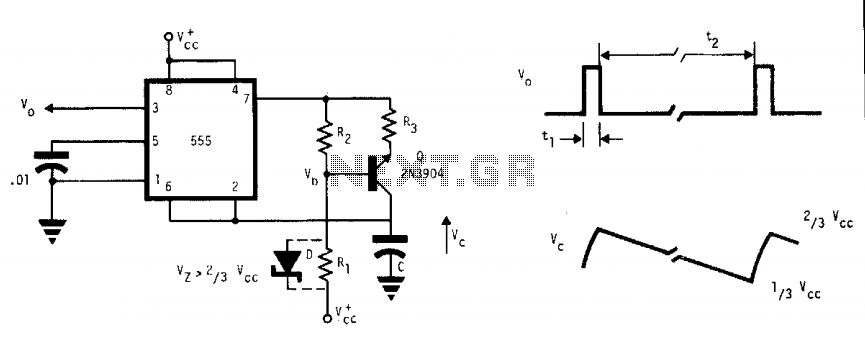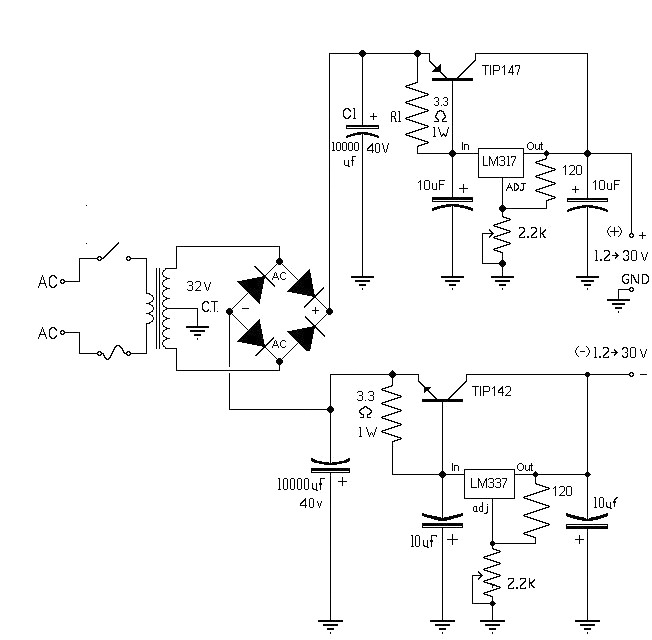
led table reading lamp circuit

This LED table or reading lamp circuit can be utilized for various applications, such as a reading lamp for a bed, a desktop or table lamp, a keyboard lamp (to illuminate the keys of a computer keyboard in low light), or as an LED emergency light during a power outage. Additionally, it can serve as a portable light source. The circuit comprises 20 super bright white LEDs, each connected with a separate current limiting resistor of 20 Ohms. The switch S1 is employed to disconnect 10 of the LEDs from the power supply, which is beneficial for reducing light intensity and conserving battery power. The circuit operates with three 1.5-volt batteries.
The LED lamp circuit features a versatile design, making it suitable for multiple lighting scenarios. The use of 20 super bright white LEDs ensures high luminosity, providing adequate illumination for reading or working in dim environments. Each LED is paired with a 20 Ohm current limiting resistor, which is essential for preventing excessive current from flowing through the LEDs, thus prolonging their lifespan and maintaining consistent brightness.
The inclusion of switch S1 allows for flexibility in light output. By disconnecting half of the LEDs, users can achieve a lower light level, which is particularly advantageous for tasks that require minimal lighting or when conserving battery life is a priority. This feature enhances the circuit's efficiency, making it suitable for extended use in portable applications.
Powering the circuit with three 1.5-volt batteries (totaling 4.5 volts) provides a reliable energy source. The battery configuration ensures that the circuit can operate effectively without the need for an external power supply, making it ideal for emergency situations or outdoor activities. The design can be easily adapted for different battery types, allowing for customization based on availability and user preferences.
Overall, this LED table lamp circuit is a practical solution for various lighting needs, combining functionality, efficiency, and portability in a single design. The careful selection of components and thoughtful circuit design contribute to its effectiveness as a versatile lighting tool.This Led table or reading lamp circuit can be used for many purposes for example as a reading lamp for bed, desktop or table lamp, keyboard lamp (to view keys of your computer keyboard in dim light), as an LED emergency light in the absence of AC supply, as a portable light etc. This led lamp circuit is consist of 20 super bright white LEDs, each LED is using a separate current limiting resistor of 20 Ohms. The switch S1 is used to disconnect the 10 LEDs from the supply, it can be useful when you want low light and also save power from the batteries. The circuit can be operated with 3 x 1. 5 volt batteries. 🔗 External reference
The LED lamp circuit features a versatile design, making it suitable for multiple lighting scenarios. The use of 20 super bright white LEDs ensures high luminosity, providing adequate illumination for reading or working in dim environments. Each LED is paired with a 20 Ohm current limiting resistor, which is essential for preventing excessive current from flowing through the LEDs, thus prolonging their lifespan and maintaining consistent brightness.
The inclusion of switch S1 allows for flexibility in light output. By disconnecting half of the LEDs, users can achieve a lower light level, which is particularly advantageous for tasks that require minimal lighting or when conserving battery life is a priority. This feature enhances the circuit's efficiency, making it suitable for extended use in portable applications.
Powering the circuit with three 1.5-volt batteries (totaling 4.5 volts) provides a reliable energy source. The battery configuration ensures that the circuit can operate effectively without the need for an external power supply, making it ideal for emergency situations or outdoor activities. The design can be easily adapted for different battery types, allowing for customization based on availability and user preferences.
Overall, this LED table lamp circuit is a practical solution for various lighting needs, combining functionality, efficiency, and portability in a single design. The careful selection of components and thoughtful circuit design contribute to its effectiveness as a versatile lighting tool.This Led table or reading lamp circuit can be used for many purposes for example as a reading lamp for bed, desktop or table lamp, keyboard lamp (to view keys of your computer keyboard in dim light), as an LED emergency light in the absence of AC supply, as a portable light etc. This led lamp circuit is consist of 20 super bright white LEDs, each LED is using a separate current limiting resistor of 20 Ohms. The switch S1 is used to disconnect the 10 LEDs from the supply, it can be useful when you want low light and also save power from the batteries. The circuit can be operated with 3 x 1. 5 volt batteries. 🔗 External reference





